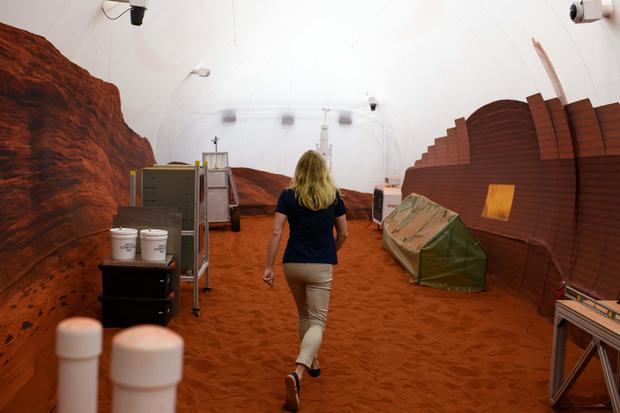4 volunteers just entered a virtual "Mars" made by NASA. They won't come back for one year.
Four volunteers entered a simulated Mars habitat on Sunday, where they are expected to remain for 378 days while facing a range of challenges designed to anticipate a real-life human mission to the red planet.
The participants — research scientist Kelly Haston, structural engineer Ross Brockwell, emergency medicine physician Nathan Jones and U.S. Navy microbiologist Anca Selariu — were selected from a pool of applicants to be part of NASA's Crew Health and Performance Exploration Analog, or CHAPEA, in its first yearlong mission. None of them are trained astronauts.
"Thank you all for your dedication to exploration," said Grace Douglas, the mission's principal investigator at NASA, during a briefing Sunday before they entered the habitat. "Our best wishes go with you."
Haston, designated by NASA as the commander of the simulated Mars mission, shared emotional remarks at the briefing about the importance of spaceflight and exploration, which she said "exemplifies some of the best qualities of humankind." Haston also praised fellow crew members, calling them an "amazing group of dedicated individuals who feel very passionate about space exploration and science."
"The crew has worked so hard this month to get ready for this mission," Haston said. "It has been very special to be a part of such a tremendous group of scientists and specialists from a diverse set of backgrounds working together to bring CHAPEA 1, the first of three missions, to reality."
Haston, Brockwell, Jones and Selariu will spend more than a year living and working in a simulated Mars environment built at the Johnson Space Center in Houston, Texas.
During their time inside of the 3D-printed, 1,700-square-foot habitat, the crew is set to carry out an array of "mission activities," including simulated spacewalks, robotic operations, growing of crops, habitat maintenance, personal hygiene and exercise, according to NASA. At 1,700 square feet, the habitat is smaller than the average U.S. single-family house. It includes a kitchen, private crew quarters and two bathrooms, along with medical, work and recreation areas.
They crew will also face a series of obstacles that likely mirror those of a true Mars mission, as researchers simulate conditions like resource limitations, equipment failure, communication delays and environmental stressors, NASA said in a news release when it introduced the crew members in April.
"The simulation will allow us to collect cognitive and physical performance data to give us more insight into the potential impacts of long-duration missions to Mars on crew health and performance," Douglas said at that time. "Ultimately, this information will help NASA make informed decisions to design and plan for a successful human mission to Mars."
The simulated mission is the first of three planned Mars surface simulations, each of which is expected to last one year. NASA says the information collected and studied over the course of these missions, along with ongoing exploration happening on and around the moon, will help send the first astronauts to Mars in the future.




